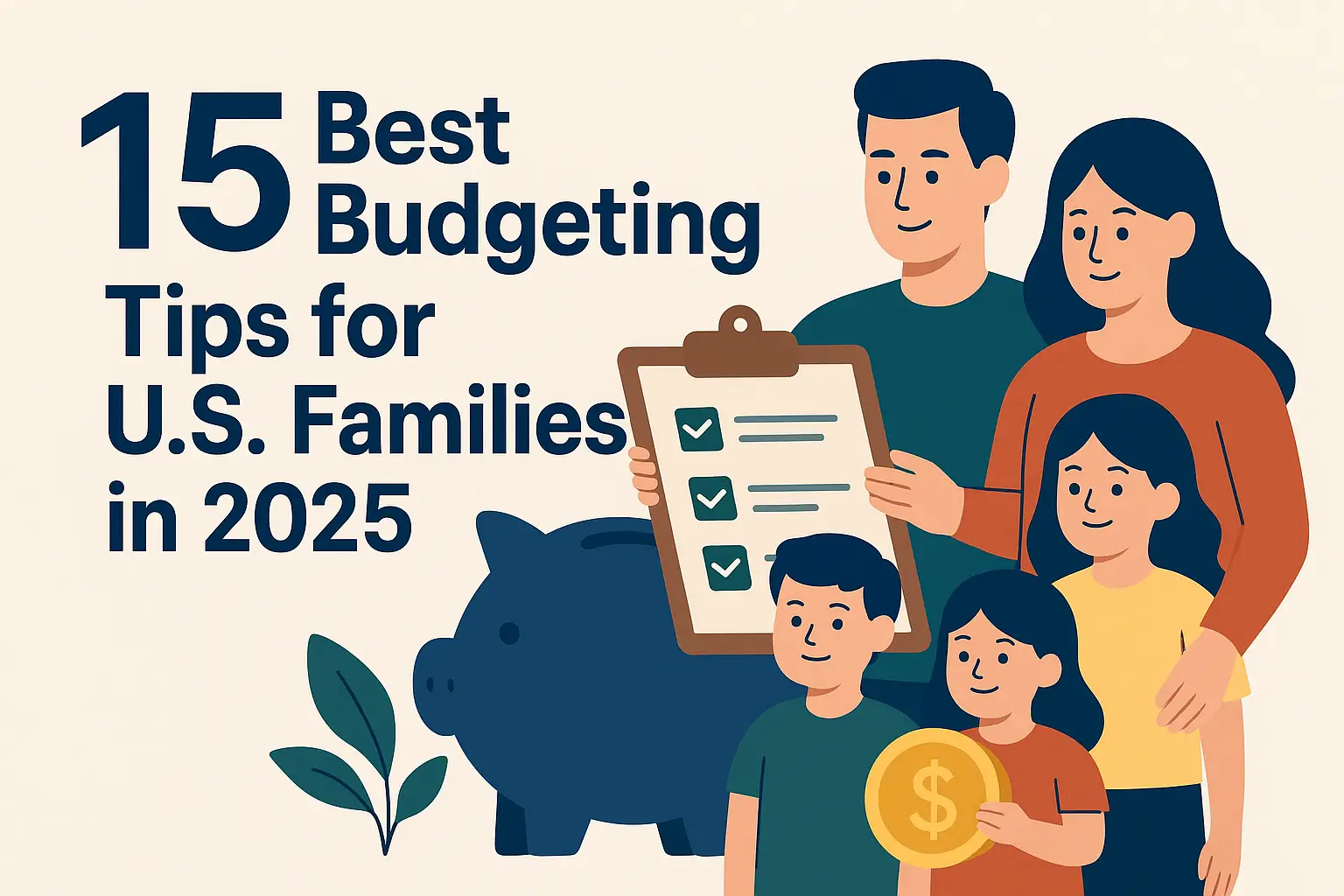
Introduction: Why Budgeting Matters for US Families
15 Best Budgeting Tips for US Families to Save More in 2025. Rising living costs, healthcare expenses, and inflation make it harder for many US families to stretch their paychecks. Without a proper budget, it’s easy to overspend and end up struggling before payday. That’s why learning budgeting tips for US families is essential for financial stability.
Budgeting doesn’t just help with paying bills—it gives peace of mind, allows savings for the future, and helps families enjoy life without financial stress.
Understanding Family Finances
Before jumping into budgeting strategies, families must understand their financial situation.
Assessing Income and Expenses
Start by calculating all sources of income—salaries, side hustles, government benefits, or rental income. Next, list every expense: rent or mortgage, utilities, groceries, childcare, insurance, and discretionary spending like dining out or entertainment.
This helps families see where money is going and where adjustments are possible.
Setting Financial Goals
Budgeting works best when families have clear goals. Examples include:
-
Paying off credit card debt
-
Saving for college tuition
-
Preparing for retirement
Setting goals makes budgeting more purposeful and rewarding. 15 Best Budgeting Tips for US Families to Save More in 2025
Top Budgeting Tips for US Families
1. Track Every Dollar
Use apps or spreadsheets to track spending. This prevents “mystery expenses” and reveals hidden spending patterns, such as impulse purchases or unused subscriptions.
2. Create a Family Budget Plan
Allocate money toward fixed expenses, savings, and flexible spending. A structured plan ensures bills are paid while still leaving room for fun.
3. Use the 50/30/20 Rule
This simple formula helps families balance money:
-
50% for needs (housing, food, bills)
-
30% for wants (entertainment, dining out)
-
20% for savings and debt repayment
4. Separate Needs from Wants
Encourage children and adults alike to identify what’s truly necessary. This helps cut wasteful spending and keeps finances under control.
5. Involve the Whole Family
Budgeting isn’t just for parents. Teach kids about money management early by letting them participate in saving goals, meal planning, or grocery shopping.
6. Automate Savings
Set up automatic transfers to savings accounts. Treat savings like a monthly bill—it ensures money grows without temptation to spend.
7. Cut Down on Subscriptions
Streaming services, gym memberships, and unused apps can silently drain money. Cancel those not in use and share family plans when possible.
8. Shop Smart for Groceries
Meal planning, buying in bulk, using coupons, and shopping store brands can reduce grocery bills by 20–30%.
9. Plan Affordable Family Activities
Instead of expensive outings, try free or low-cost activities like hiking, movie nights at home, or local community events.
10. Use Cash Envelopes for Spending
Allocate cash for categories like dining out or shopping. Once the envelope is empty, no more spending in that category.
11. Build an Emergency Fund
Aim for at least three to six months of living expenses saved in case of job loss, medical bills, or other emergencies.
12. Take Advantage of Discounts & Coupons
Use apps, loyalty programs, and cashback cards. Small savings add up over time.
13. Review Bills and Negotiate Rates
Call service providers (internet, insurance, phone) to negotiate lower rates or switch to cheaper plans.
14. Avoid Credit Card Debt
High-interest credit card debt eats away at family budgets. Pay balances in full when possible, and avoid relying on credit for everyday expenses.
15. Revisit and Adjust Your Budget Regularly
Life changes—new jobs, kids, medical needs—so should your budget. Review monthly or quarterly to stay on track. 15 Best Budgeting Tips for US Families to Save More in 2025
Common Budgeting Mistakes Families Make
-
Relying too much on credit cards
-
Not tracking small expenses
-
Forgetting irregular costs (birthdays, car repairs)
-
Setting unrealistic goals
-
Not involving all family members
Avoiding these mistakes can make budgeting more effective and sustainable.
Best Budgeting Tools and Apps for US Families
Modern families can make use of apps that simplify budgeting:
-
Mint – Tracks spending and bills automatically.
-
You Need A Budget (YNAB) – Helps families assign every dollar a purpose.
-
EveryDollar – Based on Dave Ramsey’s zero-based budgeting method.
-
GoodBudget – Digital envelope budgeting system.
These tools provide real-time insights and make budgeting less stressful.
FAQs on Budgeting for US Families
Q1. How much should a US family save each month?
Ideally, families should aim to save at least 20% of income, but even 5–10% consistently makes a difference.
Q2. What is the easiest budgeting method for beginners?
The 50/30/20 rule is simple and effective for families just starting.
Q3. Should kids be included in family budgeting?
Yes. Involving kids helps them learn financial responsibility early.
Q4. How can families cut grocery costs effectively?
Plan meals, shop with a list, use coupons, and buy in bulk when possible.
Q5. What’s the best way to avoid debt?
Pay credit card balances monthly, avoid impulse purchases, and build an emergency fund.
Q6. How often should families review their budget?
Monthly reviews are recommended, but quarterly adjustments work for long-term planning.
Conclusion: Building a Financially Stronger Family Future
Budgeting may seem overwhelming at first, but small, consistent steps lead to long-term financial freedom. By following these budgeting tips for US families, households can save more, cut unnecessary expenses, and prepare for a secure future.
Money management is not about restriction—it’s about making smarter choices today to create more opportunities tomorrow. Start with one or two changes, involve the entire family, and watch your finances transform.

